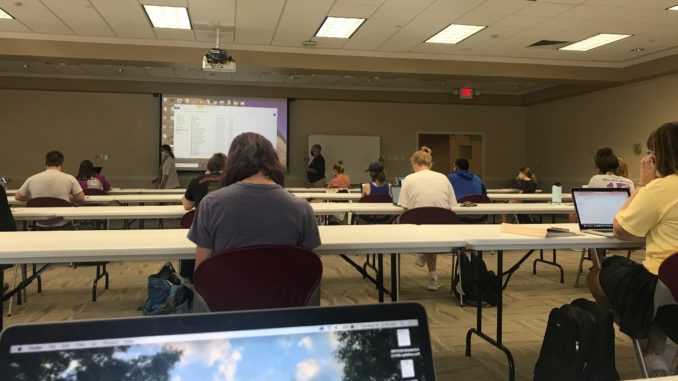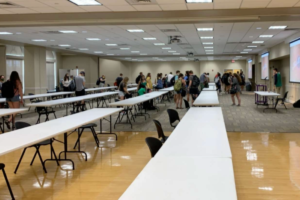
Some larger classes have been moved into the Student Union Building this semester because of COVID-19, raising some challenges for the professors teaching there.
The SUB is typically reserved for student activities outside of the classroom because it is an auxiliary building, meaning it is funded by the students. This priority was set aside for the fall semester because there are few places on campus that can hold more than thirty people with the new social distancing guidelines.
Since the Activities Room and the Georgian Rooms are not normally used for classes, there were some modifications that had to be made. These included socially distanced tables, technology upgrades and changing some aspects of the classes being taught, such as the activities students are able to do in class.
The Centers for Disease Control and Prevention guidelines state that chairs are to be spaced six feet apart and tables should face the same direction.
“We literally took a tape measurer and took a chair and measured 6 feet and did that whole process, and we had this all figured out,” Teresa West, Student Union Building manager, said. “Then the CDC came out with some new guidelines, so we had to do the whole process over, but that way we could get a few more seats.”
Following those guidelines, the Activities Room can hold 47 people, and the Georgian Room, when not split up, can fit 100.

There were also some technology upgrades that had to be made for classes to be held in the Student Union, including replacing the laptops that were in those classrooms.
While these upgrades were helpful, there have still been some technological issues, such as connecting with students on Zoom and communicating with them during class. Like many other classes, the teachers in the SUB are also giving their lectures over Zoom, for students who prefer distance learning.
These technological issues have led to some slight modifications of curriculum, because teachers cannot interact with the class as much. Rolena Stephenson, associate professor of health and exercise sciences, has had to intentionally take action to include Zoom students in the class.
“In a couple of classes I have tried to walk around the room some, and I’ve walked too far and the mic doesn’t pick up what I’m talking about on the recording,” Michael Rudy, associate professor of political science, said.
Stephenson said that the technology in the SUB doesn’t work as well as the technology in other classrooms.
While some professors feel that the toughest challenges have been dealing with the new coronavirus restrictions for in-person classes, other professors are glad to be able to have in-person classes.
“I like how they have the long tables, and I think the students do too. I don’t like how far away my students in the back are.” Rudy said. “Sometimes I can’t hear them — I will say I like’ having class in the SUB better than having a hybrid class. I’d rather see my student’s faces and be interactive while they’re there. I have to walk there further than I usually do, but I don’t have any major complaints.”
